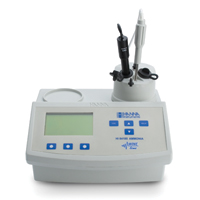FREE SHIPPING $500.00 OR MORE CODE FSHIP12.
NO CHEMICALS/GLASSWARE 1.800.967.5316
|
"Ammonia ISE meter for wine analysis, 115V" | |
|  | Quantity in Basket:
none
Code: HI84185-01
Price:$581.00
| |
| | "Ammonia ISE meter for wine analysis, 115V"....The nitrogenous compounds of must and wine are deriving from grapes and play an important role in fermentation, clarification, and potential microbial instability of wines. They are profoundly modified during the alcoholic fermentation by the physiologic activity of yeast. Thus, yeast assimilates 60-70% of the must nitrogen, ammonium ion completely disappearing during the fermentation and the total nitrogen being slightly reduced.
Ammonia is present in grapes as ammonium in a few milligrams amount and it serves as the primary form of available nitrogen for yeast metabolism. So, the content of ammonium ion can drastically decrease during the alcoholic fermentation, increasing again, especially in red wines, at the end of the malolactic fermentation because the lactic bacteria releases ammonia nitrogen in wine. The amount of ammonium ion in must influences the rapidity of fermentation start and evolution.
The ammonia concentration ranged from 24 to 209 mg/L (ppm) in grapes and from a few mg/L (ppm) to about 50 mg/L (ppm) in wine.
The HI 84185 ISE Ammonia Nitrogen meter measures the ammonia nitrogen (N-NH3) content in wine using an ion selective electrode. The used method is double standard addition, a simple and rapid method of analysis, and the result is readily displayed in ammonia nitrogen (N-NH3) mg/L (ppm).
|
| |